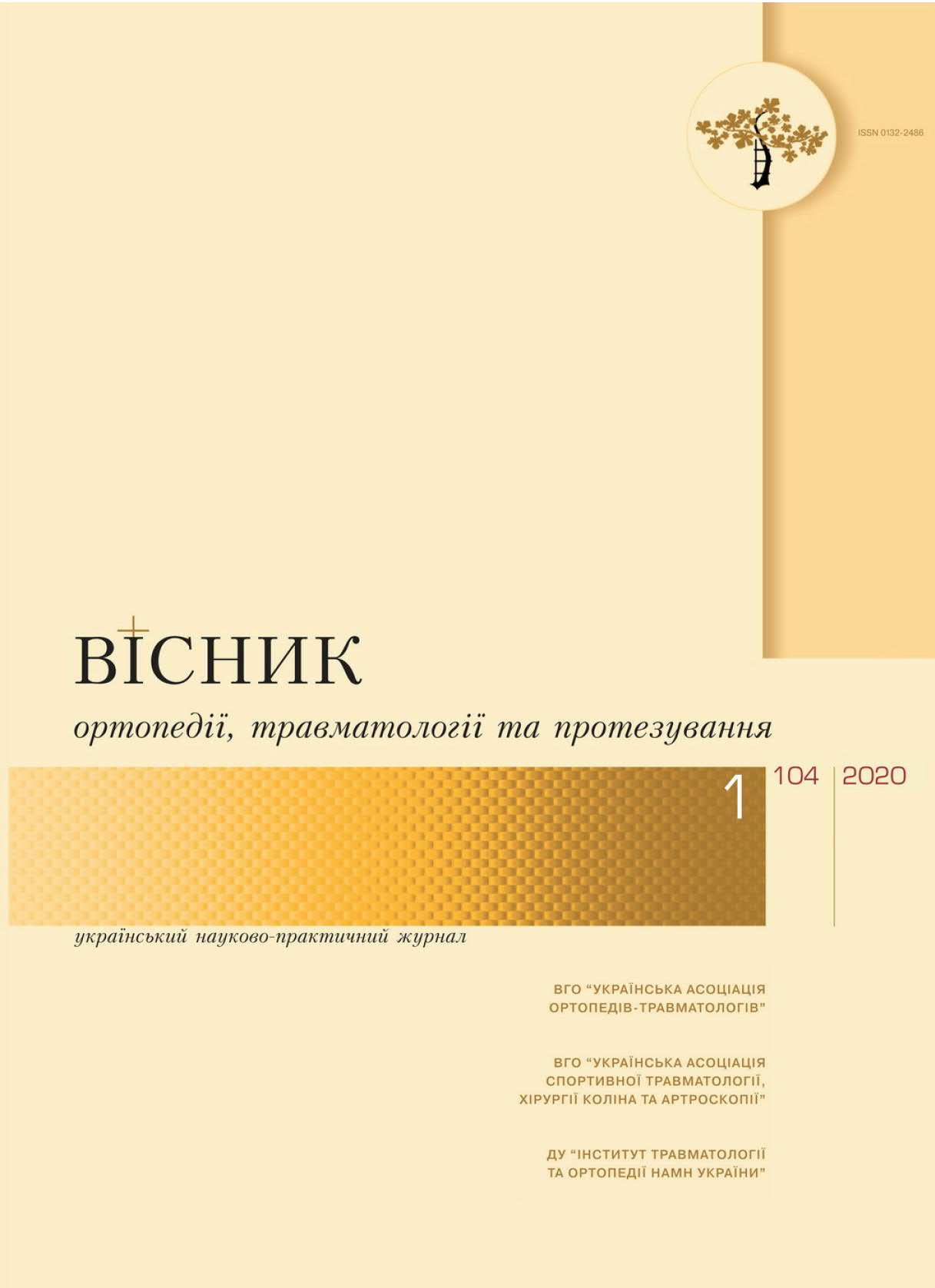Abstract
Summary. Despite the rapid development of medical technologies, the problem of restoration the functions of the spinal cord remains unsolved.
Objective: to improve the quality of life of patients with the consequences of traumatic damage to the spinal cord.
Materials and Methods. The study is based on an analysis of the treatment results of 95 patients with the consequences of traumatic damage to the cervical segments of the spinal cord. Depending on the severity of the spinal cord injury, the patients were distributed as follows: group ASIA A – 43 patients, group B – 37 patients, and group C – 15 patients. Reconstructive surgery was performed on patients from 6 months to 2 years after the injury. Among the methods of rehabilitation treatment, chronic epidural electrical stimulation of the spinal cord (as the first stage of rehabilitation treatment) was used in all patients, neurotization of the anterior interosseous nerve (anterior interosseous nerve AIN) by the branch of the muscular cutaneous nerve – in 38 patients, transposition of the tendon of the deltoid muscle to the tendon of the triceps of the shoulder – in 8 patients.
Results. The ASIA impairment scale, SCIM (Spinal cord independence measure scale) and MRC (Medical Research Council scale) were used to evaluate treatment outcomes. The results were evaluated 18 months after reconstructive surgery. In the ASIA A group, the quality of life improved in 74.4% of patients, due to an improvement of the upper extremity function. In the ASIA B group, an improvement in the quality of life was noted in 83.7% of patients, both due to improved self-care and mobility, and due to improved control of the function of the pelvic organs. In the ASIA C group, improved quality of life was mainly due to improved mobility.
Conclusions. Complex restorative treatment of patients with incomplete cervical spinal cord injury allowed to improve the quality of life due to correction of segmentary and conductive violations of the spinal cord. In patients with complete spinal cord injury, only segmentary violations are suitable for correction.
References
[No authors listed] Spinal Cord Injury (SCI) 2016 Facts and Figures at a Glance. J Spinal Cord Med. 2016 Jul;39(4):493-4. doi: 10.1080/10790268.2016.1210925. PMID: 27471859. PMCID: PMC5102286.
Nakajima H, Takahashi A, Kitade I, Watanabe S, Honjoh K, Matsumine A. Prognostic factors and optimal management for patients with cervical spinal cord injury without major bone injury. J Orthop Sci. 2019 Mar;24(2):230-236. doi: 10.1016/j.jos.2018.10.001. PMID: 30361169.
Witiw CD, Fehlings MG. Acute Spinal Cord Injury. J Spinal Disord Tech. 2015 Jul;28(6):202-10. doi: 10.1097/BSD.0000000000000287. PMID: 26098670.
Kjell J, Olson L. Rat models of spinal cord injury: from pathology to potential therapies. Dis Model Mech. 2016;9(10):1125-37. DOI: 10.1242/dmm.025833.
Fakhoury M. Spinal cord injury: overview of experimental approaches used to restore locomotor activity. Rev Neurosci. 2015;26(4):397-405. doi: 10.1515/revneuro-2015-0001. PMID: 25870961.
Liem L, Russo M, Huygen FJ, Van Buyten JP, Smet I, Verrills P, Cousins M, Brooker C, Levy R, Deer T, Kramer J. One-year outcomes of spinal cord stimulation of the dorsal root ganglion in the treatment of chronic neuropathic pain. Neuromodulation. 2015 Jan;18(1):41-8; discussion 48-9. doi: 10.1111/ner.12228. PMID: 25145467.
Taylor RS, Desai MJ, Rigoard P, Taylor RJ. Predictors of pain relief following spinal cord stimulation in chronic back and leg pain and failed back surgery syndrome: a systematic review and meta-regression analysis. Pain Pract. 2014 Jul;14(6):489-505. doi: 10.1111/papr.12095. PMID: 23834386. PMCID: PMC4238825.
Rascoe A, Sharma P, Shah PK. Development of an Activity-Dependent Epidural Stimulation System in Freely Moving Spinal Cord Injured Rats: A Proof of Concept Study. Front Neurosci. 2018 Jul 23;12:472. doi: 10.3389/fnins.2018.00472. eCollection 2018. PMID: 30083089. PMCID: PMC6064745.
Alam M, Garcia-Alias G, Jin B, Keyes J, Zhong H, Roy RR, Gerasimenko Y, Lu DC, Edgerton VR. Electrical neuromodulation of the cervical spinal cord facilitates forelimb skilled function recovery in spinal cord injured rats. Exp Neurol. 2017 May;291:141-150. doi: 10.1016/j.expneurol.2017.02.006. PMID: 28192079. PMCID: PMC6219872.
Possover M. Recovery of sensory and supraspinal control of leg movement in people with chronic paraplegia: a case series. Arch Phys Med Rehabil. 2014 Apr;95(4):610-4. doi: 10.1016/j.apmr.2013.10.030. PMID: 24269993.
Harkema S, Gerasimenko Y, Hodes J, Burdick J, Angeli C, Chen Y, Ferreira C, Willhite A, Rejc E, Grossman RG, Edgerton VR. Effect of epidural stimulation of the lumbosacral spinal cord on voluntary movement, standing, and assisted stepping after motor complete paraplegia: a case study. Lancet. 2011 Jun 4;377(9781):1938-47. doi: 10.1016/S0140-6736(11)60547-3. PMID: 21601270. PMCID: PMC3154251.
Catz A, Itzkovich M, Agranov E, Ring H, Tamir A. SCIM--spinal cord independence measure: a new disability scale for patients with spinal cord lesions. Spinal Cord. 1997 Dec;35(12):850-6. DOI: 10.1038/sj.sc.3100504. PMID: 9429264.
Tsymbaliuk V.I, Yaminskyi Y.Y Restorarive surgery of spinal cord: Avicena, 2009. Ukraine 248 с. ISBN 978-966-2144-06-2. - ISBN 978-966-1568-23-4.
Hawasli AH, Chang J, Reynolds MR, Ray WZ. Transfer of the brachialis to the anterior interosseous nerve as a treatment strategy for cervical spinal cord injury: technical note. Global Spine J. 2015 Apr;5(2):110-7. doi: 10.1055/s-0034-1396760. PMID: 25844283. PMCID: PMC4369208.
Song W, Amer A, Ryan D, Martin JH. Combined motor cortex and spinal cord neuromodulation promotes corticospinal system functional and structural plasticity and motor function after injury. Exp Neurol. 2016 Mar;277:46-57. doi: 10.1016/j.expneurol.2015.12.008. PMID: 26708732.
Fox IK, Davidge KM, Novak CB, Hoben G, Kahn LC, Juknis N, Ruvinskaya R, Mackinnon SE. Use of peripheral nerve transfers in tetraplegia: evaluation of feasibility and morbidity. Hand (N Y). 2015 Mar;10(1):60-7. doi: 10.1007/s11552-014-9677-z. PMID: 25767422. PMCID: PMC4349853.

This work is licensed under a Creative Commons Attribution 4.0 International License.

